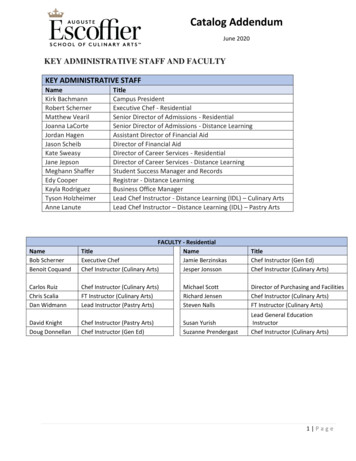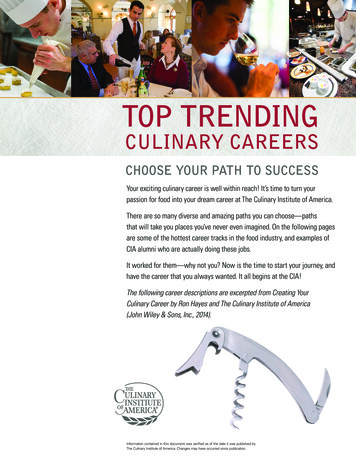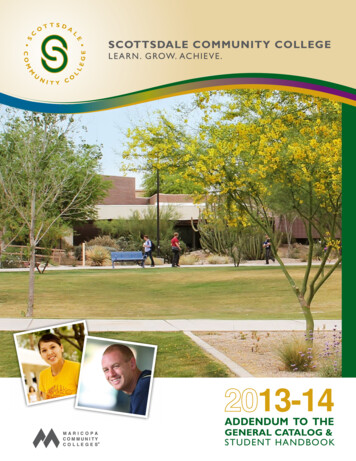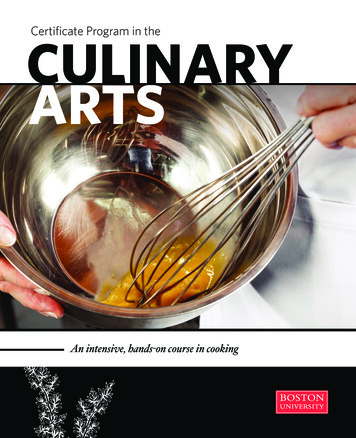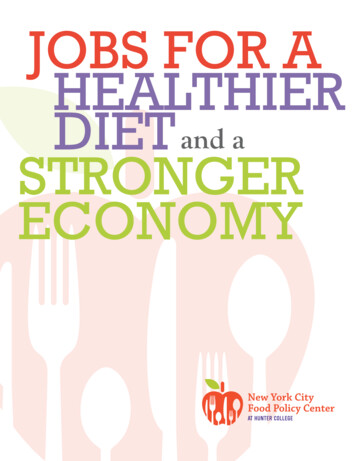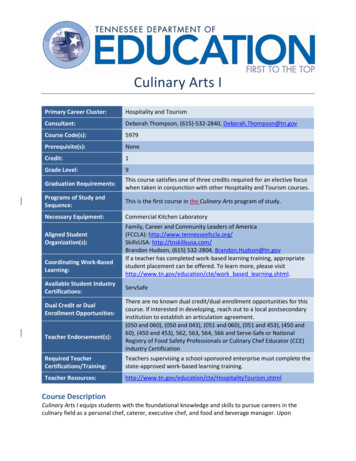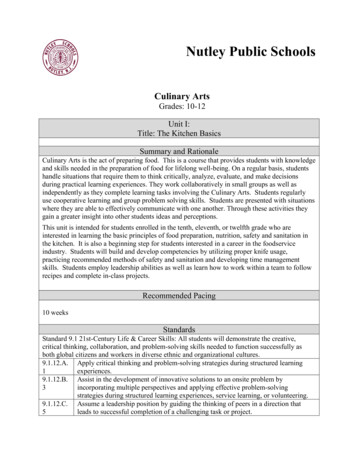
Transcription
Nutley Public SchoolsCulinary ArtsGrades: 10-12Unit I:Title: The Kitchen BasicsSummary and RationaleCulinary Arts is the act of preparing food. This is a course that provides students with knowledgeand skills needed in the preparation of food for lifelong well-being. On a regular basis, studentshandle situations that require them to think critically, analyze, evaluate, and make decisionsduring practical learning experiences. They work collaboratively in small groups as well asindependently as they complete learning tasks involving the Culinary Arts. Students regularlyuse cooperative learning and group problem solving skills. Students are presented with situationswhere they are able to effectively communicate with one another. Through these activities theygain a greater insight into other students ideas and perceptions.This unit is intended for students enrolled in the tenth, eleventh, or twelfth grade who areinterested in learning the basic principles of food preparation, nutrition, safety and sanitation inthe kitchen. It is also a beginning step for students interested in a career in the foodserviceindustry. Students will build and develop competencies by utilizing proper knife usage,practicing recommended methods of safety and sanitation and developing time managementskills. Students employ leadership abilities as well as learn how to work within a team to followrecipes and complete in-class projects.Recommended Pacing10 weeksStandardsStandard 9.1 21st-Century Life & Career Skills: All students will demonstrate the creative,critical thinking, collaboration, and problem-solving skills needed to function successfully asboth global citizens and workers in diverse ethnic and organizational cultures.9.1.12.A. Apply critical thinking and problem-solving strategies during structured learning1experiences.9.1.12.B. Assist in the development of innovative solutions to an onsite problem by3incorporating multiple perspectives and applying effective problem-solvingstrategies during structured learning experiences, service learning, or volunteering.9.1.12.C. Assume a leadership position by guiding the thinking of peers in a direction that5leads to successful completion of a challenging task or project.
Nutley Public Schools9.1.12.F.2Demonstrate a positive work ethic in various settings, including the classroom andduringstructured learning experiences.Career Awareness, Exploration, and Preparation 9.3: 21st-Century Career Awareness,Exploration, and Preparation: All students will apply knowledge about and engage in the processof career awareness, exploration, and preparation in order to navigate the globally competitivework environment of the information age.9.3.12.C. Develop job readiness skills by participating in structured learning experiences and6employment seeking opportunities.9.3.12.C.Evaluate the responsibilities of employers and employees for maintaining workplace11safety, and explain health rights related to a particular occupation/career.Career and Technical Education 9.4: All students who complete a career and technical educationprogram will acquire academic and technical skills for careers in emerging and establishedprofessions that lead totechnical skill proficiency, credentials, certificates, licenses, and/or degrees.9.4.12.I.8 Select and employ appropriate reading and communication strategies to learn and usetechnical concepts and vocabulary in practice.9.4.12.I.1 Evaluate and use information resources to accomplish specific occupational tasks.19.4.12.I.1 Develop and interpret tables, charts, and figures to support written and oral6communications.9.4.12.I.3 Demonstrate knowledge of personal and jobsite safety rules and regulations to9maintain safe and healthful working conditions and environments.9.4.12.I.4 Assess types and sources of workplace hazards common to hospitality and tourism7work settings in order to demonstrate a working understanding of key health andsafety concerns in this cluster.9.4.12.I.4 Demonstrate knowledge of methods used in this cluster to control hazards and8maintain safe environments.9.4.12.I.4 Review safety and sanitation procedures and apply them to ensure a safe and healthy9workenvironment.9.4.12.I.5 Employ teamwork skills to achieve collective goals and use team members’ talents6effectively.9.4.12.I.6 Identify and demonstrate positive work behaviors and personal qualities needed to6succeed in the classroom and/or to be employable.9.4.12.I.5 Establish and maintain effective relationships in order to accomplish objectives and7tasks.CRP1.CRP2.CRP3.CRP4.CRP5.CRP6.Act as a responsible and contributing citizen and employee.Apply appropriate academic and technical skills.Attend to personal health and financial well-being.Communicate clearly and effectively and with reason.Consider the environmental, social and economic impacts of decisions.Demonstrate creativity and innovation.
Nutley Public SchoolsCRP7.CRP8.CRP9.CRP10.CRP11.CRP12.Employ valid and reliable research strategies.Utilize critical thinking to make sense of problems and persevere in solving them.Model integrity, ethical leadership and effective management.Plan education and career paths aligned to personal goals.Use technology to enhance productivity.Work productively in teams while using cultural global competence.Interdisciplinary ConnectionsStandard x.xStudents use skills associated with mathematics, art, digital photography, chemistry,and foreign languages.Integration of TechnologyStandard x.xStudents learn and practice the skills associated with technology used in variousaspects of the kitchen.Instructional FocusEnduring Understandings Following safe, sanitary, standard procedures yields successful results and forms afoundation for future undertakings in the kitchen. Success in the workplace/food & hospitality industry requires understanding of andadherence to industry protocols and standards of quality. Assume a leadership position by guiding the thinking of peers in a direction that leads tosuccessful completion of a challenging task or project. Demonstrate a positive work ethic in various settings, including the classroom and duringstructured learning experiences.Essential Questions How do chefs/cooks choose equipment/tools/recipes for their kitchens? How do chefs/cooks keep their kitchens and food safe, sanitary, and efficient? What does it take to be a success in the food & hospitality industry?Evidence of Learning (Assessments) Equipment identification quiz Knife safety quiz Equipment location/function quiz Tests and quizzes as they relate to the material Completion of various cooking labs/activities
Nutley Public Schools Proper equipment usage on a regular basis Adhering to rubrics (cooking, presentation, sanitation) Reflective journals for each recipe completed Notebook with recipes, methods, other notes and journalsObjectivesStudents will know: Names and functions of food preparation equipment and tools Recipe terminology, measuring techniques, and basic knife skills Safety procedures and potential hazards in the kitchen Sanitary food handling, preparation, and storage Time management, communication and collaboration skills as they relate to foodpreparation in the Kitchen lab work areaStudents will be able to: Identify a variety of kitchen tools/utensils and equipment and explain their functions Demonstrate correct techniques for measuring dry and liquid ingredients. Demonstrate proper basic knife skills. Describe a safe and sanitary kitchen environment. Demonstrate how to control various hazards in the kitchen. Efficiently and cooperatively organize time and responsibilities during the classroom labs.IntegrationTechnology Integration Internet usage for research and ideas Smartboard usage for visual aids and recipe documentation Appliances and equipment used for culinary artsWriting Integration Regular Journal entries Restaurant review writing assignments Peer critiques and evaluations Written recipe development Regular notebook usage and maintenanceCompetenciesSuggested Resources Textbooks, internet, youtube tutorials, guest speakers, teacher knowledge / experience,curriculum content.
Nutley Public SchoolsCulinary ArtsGrade: 10-12Unit II:Title: Nutrition and Meal PlanningSummary and RationaleCulinary Arts is the act of preparing food. Culinary Arts is a course that provides students withknowledge and skills for lifelong well-being. On a regular basis, students deal with situations thatrequire them to think critically, analyze, evaluate, and make decisions during practical learningexperiences. They work collaboratively in small groups as well as independently as theycomplete learning tasks involving the Culinary Arts. Cooperative learning and group problemsolving situations are a regular occurrence. Students are presented with situations where they areable to effectively communicate with one another. Through these activities they gain a greaterinsight into others' ideas, thoughts and perceptions.The second unit of study focuses on nutrition and healthy meal planning. Within that context,students examine food handling, preparation, and storage; they deepen their understanding ofnutrients and balanced meal planning; they investigate career opportunities in the field; and theyprepare and evaluate food products.15 weeksRecommended PacingStandardsStandard 9.1 21st-Century Life & Career Skills: All students will demonstrate the creative, criticalthinking, collaboration, and problem-solving skills needed to function successfully as both globalcitizens and workers in diverse ethnic and organizational cultures.9.1.12.A. Apply critical thinking and problem-solving strategies during structured learning1experiences.9.1.12.B. Assist in the development of innovative solutions to an onsite problem by3incorporating multiple perspectives and applying effective problem-solving strategiesduring structured learning experiences, service learning, or volunteering.9.1.12.C. Assume a leadership position by guiding the thinking of peers in a direction that5leads to successful completion of a challenging task or project.9.1.12.F.2 Demonstrate a positive work ethic in various settings, including the classroom andduringstructured learning experiences.Career Awareness, Exploration, and Preparation 9.3: 21st-Century Career Awareness,Exploration, and Preparation: All students will apply knowledge about and engage in the processof career awareness, exploration, and preparation in order to navigate the globally competitivework environment of the information age.99.3.12.C Develop job readiness skills by participating in structured learning experiences and.6employment seeking opportunities.
Nutley Public Schools9.3.12.C. Evaluate the responsibilities of employers and employees for maintaining workplace11safety, and explain health rights related to a particular occupation/career.Career and Technical Education 9.4: All students who complete a career and technical educationprogram will acquire academic and technical skills for careers in emerging and establishedprofessions that lead totechnical skill proficiency, credentials, certificates, licenses, and/or degrees.9.4.12.I.8 Select and employ appropriate reading and communication strategies to learn and usetechnical concepts and vocabulary in practice.9.4.12.I.1 Evaluate and use information resources to accomplish specific occupational tasks.19.4.12.I.1 Develop and interpret tables, charts, and figures to support written and oral6communications.99.4.12.I. Demonstrate knowledge of personal and jobsite safety rules and regulations to39maintain safe and healthful working conditions and environments.9.4.12.I.4 Assess types and sources of workplace hazards common to hospitality and tourism7work settings in order to demonstrate a working understanding of key health andsafety concerns in this cluster.9.4.12.I.4 Demonstrate knowledge of methods used in this cluster to control hazards and8maintain safe environments.9.4.12.I.4 Review safety and sanitation procedures and apply them to ensure a safe and healthy9workenvironment.9.4.12.I.5 Employ teamwork skills to achieve collective goals and use team members’ talents6effectively.9.4.12.I.6 Identify and demonstrate positive work behaviors and personal qualities needed to6succeed in the classroom and/or to be employable.9.4.12.I.5 Establish and maintain effective relationships in order to accomplish objectives and7tasks.Career Ready RP9.CRP10.CRP11.CRP12.Act as a responsible and contributing citizen and employee.Apply appropriate academic and technical skills.Attend to personal health and financial well-being.Communicate clearly and effectively and with reason.Consider the environmental, social and economic impacts of decisions.Demonstrate creativity and innovation.Employ valid and reliable research strategies.Utilize critical thinking to make sense of problems and persevere in solving them.Model integrity, ethical leadership and effective management.Plan education and career paths aligned to personal goals.Use technology to enhance productivity.Work productively in teams while using cultural global competence.
Nutley Public SchoolsInterdisciplinary ConnectionsStandard x.xStudents use skills associated with mathematics, art, digital photography, chemistry,and foreign languages.Integration of TechnologyStandard x.xStudents learn and practice the skills associated with technology used in variousaspects of the kitchen.Instructional FocusEnduring Understandings Safety and sanitation first because improper food handling and kitchen procedures canhave life threatening results. Dietary guidelines vary for individuals based on age, activity level, weight, metabolism,and health. Professional and home cooks analyze food content and preparation for wellness. Savvy consumers utilize limited resources in food planning and preparation in everydaylife. Career development awareness leads to employment.Essential Questions What are the challenges and benefits of working in teams? What are “whole foods?” What makes foods “healthy?” What does “Organic” mean? How do chefs/cooks keep their kitchens and food safe, sanitary, and efficient? How do chefs/cooks choose and use their kitchen tools and equipment during foodpreparation? Does the amount and quality of food intake matter? Why or why not? How do savvy consumers eat a healthy diet on a limited budget? What does it take to be a success in the food industry?Evidence of Learning (Assessments) Tests and quizzes as they relate to the material Completion of various cooking labs/activities Proper equipment usage on a regular basis Adhering to rubrics (cooking, presentation, sanitation) Reflective journals for each recipe completed Notebook with recipes, methods, other notes and journalsObjectivesStudents will know: The USDA food group guidelines Safety procedures and hazards in the foods lab
Nutley Public Schools Sanitary food handling, preparation, and storage Recipe terminology, names/functions of food tools and equipment, measuring techniques,and basic knife skills Time management and communication and collaboration skills as they relate to foodpreparation in the kitchen lab work area Criteria for making consumer decisions Range of careers in the foods industryStudents will be able to: Describe a safe and sanitary kitchen environment Demonstrate correct techniques for measuring dry and liquid ingredients Demonstrate proper basic knife skills Identify a variety of kitchen tools/utensils and equipment and explain their functions Efficiently and cooperatively organize time and responsibilities during the classroom labs Prepare a variety of food products high in each of the nutrient classes Plan nutritious, well-planned menus within a budget using basic meal patterns and USDAfood group guidelines Demonstrate how to control various hazards in the kitchen Plan and carry out various cooking lab activities including on-site and off-site cateringevents. Make wise decisions in the marketplaceIntegrationTechnology Integration Internet usage for research and ideas Smartboard usage for visual aids and recipe documentation Appliances and equipment used for culinary artsWriting Integration Regular Journal entries Restaurant review writing assignments Peer critiques and evaluations Regular notebook usage and upkeep Written recipe developmentCompetenciesSuggested ResourcesTextbooks, internet, youtube tutorials, guest speakers, teacher knowledge / experience,curriculum content.
Nutley Public SchoolsCulinary ArtsGrades: 10-12Unit III:Title: The Basic Food Groups-RecipesSummary and RationaleCulinary Arts is the act of preparing food. Culinary Arts is a course that provides students withknowledge and skills for lifelong well-being. On a regular basis, students deal with situations thatrequire them to think critically, analyze, evaluate, and make decisions during practical learningexperiences. They work collaboratively in small groups as well as independently as theycomplete learning tasks involving the Culinary Arts. Cooperative learning and group problemsolving situations are a regular occurrence. Students are presented with situations where they areable to see another's point of view and effectively communicate with one another. Through theseactivities they gain a greater insight into others' ideas, thoughts and perceptions.This unit is intended for students enrolled in the tenth, eleventh, or twelfth grade who areinterested in continuing to learn the principles of food preparation and nutrition, safety andsanitation in the kitchen, table service and etiquette, and consumerism. It is a continuing step forstudents interested in a career in the foodservice industry.Students gain in-depth knowledge and understanding of food preparation, the nutrients in foods,and the effects of proper food preparation on those nutrients. They analyze the USDA foodgroups and guidelines and prepare a variety of foods from each category and evaluate the recipesused for their health benefits. Students utilize information with respect to health and nutrition toassist them in building the foundation to a future wellness and a possible career in the foodsindustry.15 weeksRecommended PacingStandardsStandard 9.1 21st-Century Life & Career Skills: All students will demonstrate the creative,critical thinking, collaboration, and problem-solving skills needed to function successfully as bothglobal citizens and workers in diverse ethnic and organizational cultures.9.1.12.A.1Apply critical thinking and problem-solving strategies during structured learningexperiences.9.1.12.B.3Assist in the development of innovative solutions to an onsite problem byincorporating multiple perspectives and applying effective problem-solvingstrategies during structured learning experiences, service learning, or volunteering.9.1.12.C.5Assume a leadership position by guiding the thinking of peers in a direction thatleads to successful completion of a challenging task or project.99.1.12.F.2 Demonstrate a positive work ethic in various settings, including the classroom andduringstructured learning experiences.
Nutley Public SchoolsCareer Awareness, Exploration, and Preparation 9.3: 21st-Century Career Awareness,Exploration, and Preparation: All students will apply knowledge about and engage in the processof career awareness, exploration, and preparation in order to navigate the globally competitivework environment of the information age.9.3.12.C.6 Develop job readiness skills by participating in structured learning experiences andemployment seeking opportunities.9.3.12.C.1 Evaluate the responsibilities of employers and employees for maintaining workplace1safety, and explain health rights related to a particular occupation/career.Career and Technical Education 9.4: All students who complete a career and technical educationprogram will acquire academic and technical skills for careers in emerging and establishedprofessions that lead totechnical skill proficiency, credentials, certificates, licenses, and/or degrees.9.4.12.I.8Select and employ appropriate reading and communication strategies to learn anduse technical concepts and vocabulary in practice.9.4.12.I.11 Evaluate and use information resources to accomplish specific occupational tasks.9.4.12.I.16 Develop and interpret tables, charts, and figures to support written and oralcommunications.9.4.12.I.39 Demonstrate knowledge of personal and jobsite safety rules and regulations tomaintain safe and healthful working conditions and environments.9.4.12.I.47 Assess types and sources of workplace hazards common to hospitality and tourismwork settings in order to demonstrate a working understanding of key health andsafety concerns in this cluster.9.4.12.I.48 Demonstrate knowledge of methods used in this cluster to control hazards andmaintain safe environments.9.4.12.I.49 Review safety and sanitation procedures and apply them to ensure a safe and healthyworkenvironment.9.4.12.I.56 Employ teamwork skills to achieve collective goals and use team members’ talentseffectively.9.4.12.I.66 Identify and demonstrate positive work behaviors and personal qualities needed tosucceed in the classroom and/or to be employable.9.4.12.I.57 Establish and maintain effective relationships in order to accomplish objectives andtasks.Career Ready ct as a responsible and contributing citizen and employee.Apply appropriate academic and technical skills.Attend to personal health and financial well-being.Communicate clearly and effectively and with reason.Consider the environmental, social and economic impacts of decisions.Demonstrate creativity and innovation.Employ valid and reliable research strategies.Utilize critical thinking to make sense of problems and persevere in solving them.
Nutley Public SchoolsCRP9.CRP10.CRP11.CRP12.Model integrity, ethical leadership and effective management.Plan education and career paths aligned to personal goals.Use technology to enhance productivity.Work productively in teams while using cultural global competence.Interdisciplinary ConnectionsStandard x.xStudents use skills associated with mathematics, art, digital photography, chemistry,and foreign languages.Integration of TechnologyStandard x.xStudents learn and practice the skills associated with technology used in variousaspects of the kitchenInstructional FocusEnduring Understandings The USDA food groups and guidelines present relative, not absolute, guidelines for abalanced diet. Dietary requirements differ for individuals, depending on variables such as age, activitylevel, weight, and overall health. Food is one of the most basic elements necessary to human beings and must be properlyprepared and handled for human health and wellness. The ability to demonstrate proper food safety and sanitation, measuring, knife skills,recipe implementation, and nutritious cooking techniques and methods in the kitchen is alife‐long skill that enhances independence and overall well-being. Each job, career and profession has a set of preparation requirements, career explorationexperiences and different opportunities for personal and professional growth andsatisfaction.Essential Questions What are “whole foods?” What makes foods “healthy?” How does food quality affect cost? What are the consequences of our food choices in terms of wellness? How do chefs/cooks organize their kitchens and kitchen procedures for safe, sanitary,nutritious, and efficient food preparation? How do I prepare for a career in the foods industry? Why are the culinary arts considered lifelong skills?Evidence of Learning (Assessments) Completion of various cooking labs/activities Proper equipment usage on a regular basis Adhering to rubrics (cooking, presentation, sanitation)
Nutley Public Schools Test and quizzes as they relate to the material Reflective journals for each recipe completed Notebook with recipes, methods, other notes and journalsObjectivesStudents will know: Different parts of a recipe (ingredients, servings, steps) and the equipment/tool names andfunctions for implementing the recipes Language and mathematical skills for reading and carrying out recipes Procedures, skills, and protocols for safe, sanitary, efficient, and nutritious food preparation Characteristics, sources, and functions of the six nutrient classes and their impact on longterm good health Menus, meals, and foods that are compatible with the USDA food groups and guidelines Sound decision making processes.Students will be able to: Interpret and follow a recipe using correct equipment/tools, equivalents and propermeasuring techniques, and proper basic knife skills Prepare a variety of products from each of the basic food groups in a safe and sanitary way Efficiently and cooperatively organize time and responsibilities during the classroom labs Analyze menus and food preparation techniques as they relate to nutritious implementationof healthy food planning and food preparation Clean and organize the kitchen workplace in a safe and sanitary way. Discuss the value of culinary arts as a life skillIntegrationTechnology Integration Internet usage for research and ideas Smartboard usage for visual aids and recipe documentation Appliances and equipment used for culinary artsWriting Integration Regular Journal entries Restaurant review writing assignments Peer critiques and evaluations Regular notebook usage and upkeep Written recipe developmentCompetenciesSuggested Resources
Nutley Public Schools Textbooks, internet, youtube tutorials, guest speakers, teacher knowledge / experience,curriculum content.
Culinary Arts. Grades: 10-12. Unit I: Title: The Kitchen Basics Summary and Rationale Culinary Arts is the act of preparing food. This is a course that provides students with knowledge . Textbooks, internet, youtube tutorials, guest speakers, teacher knowledge / experience, curriculum content. Nutley Public Schools Culinary Arts: Grade: 10-12:
